Sony RX100 III vs Panasonic FZ1000
The Sony Cyber-shot DSC-RX100 III and the Panasonic Lumix DMC-FZ1000 are two digital cameras that were announced, respectively, in May 2014 and June 2014. Both the RX100 III and the FZ1000 are fixed lens compact cameras that are equipped with an one-inch sensor. Both cameras offer a resolution of 20 megapixels.
Below is an overview of the main specs of the two cameras as a starting point for the comparison.

Check RX100 III offers at
ebay.com

Check FZ1000 offers at
ebay.com
Going beyond this snapshot of core features and characteristics, what are the differences between the Sony Cyber-shot DSC-RX100 III and the Panasonic Lumix DMC-FZ1000? Which one should you buy? Read on to find out how these two cameras compare with respect to their body size, their imaging sensors, their shooting features, their input-output connections, and their reception by expert reviewers.
Body comparison
The side-by-side display below illustrates the physical size and weight of the Sony RX100 III and the Panasonic FZ1000. The two cameras are presented according to their relative size. Three consecutive perspectives from the front, the top, and the back are available. All width, height and depth measures are rounded to the nearest millimeter.
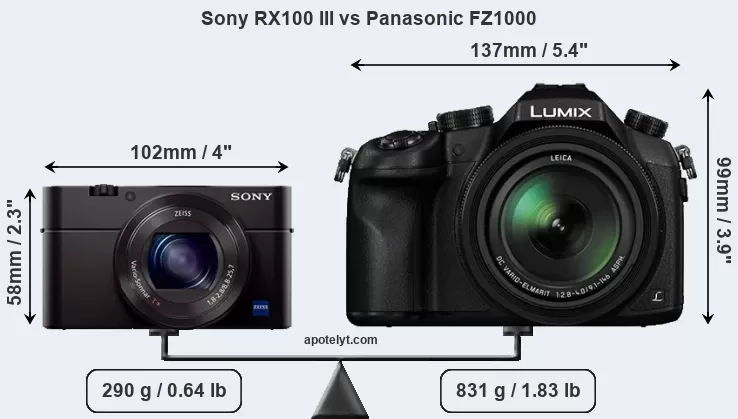
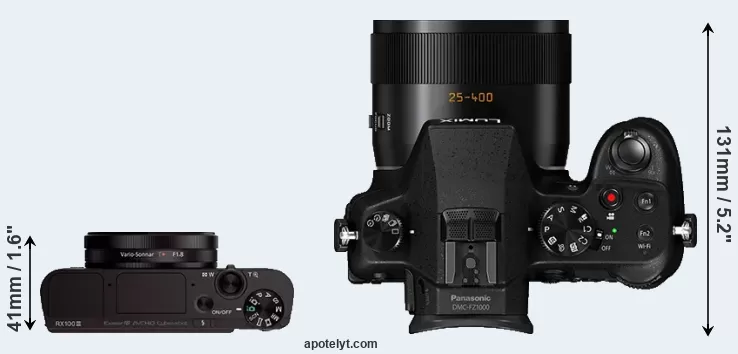
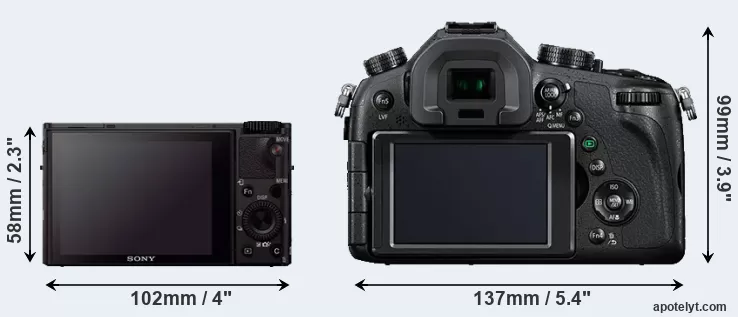
If the front view area (width x height) of the cameras is taken as an aggregate measure of their size, the Panasonic FZ1000 is considerably larger (129 percent) than the Sony RX100 III. Moreover, the FZ1000 is substantially heavier (187 percent) than the RX100 III. In this context, it is worth noting that neither the RX100 III nor the FZ1000 are weather-sealed.
Concerning battery life, the RX100 III gets 320 shots out of its Sony NP-BX1 battery, while the FZ1000 can take 360 images on a single charge of its Panasonic DMW-BLC12 power pack. The power pack in the RX100 III can be charged via the USB port, so that it is not always necessary to take the battery charger along when travelling.
The following table provides a synthesis of the main physical specifications of the two cameras and other similar ones. If you would like to visualize and compare a different camera combination, you can navigate to the CAM-parator app and make your selection from a broad list of cameras there.

| Camera Model |
Camera Width |
Camera Height |
Camera Depth |
Camera Weight |
Battery Life |
Weather Sealing |
Camera Launch |
Launch Price (USD) |
Street Price |
||
|---|---|---|---|---|---|---|---|---|---|---|---|
| 1. | Sony RX100 III | 102 mm | 58 mm | 41 mm | 290 g | 320 | n | May 2014 | 799 | ebay.com | |
| 2. | Panasonic FZ1000 | 137 mm | 99 mm | 131 mm | 831 g | 360 | n | Jun 2014 | 899 | ebay.com | |
| 3. | Canon G3 X | 123 mm | 77 mm | 105 mm | 733 g | 300 | Y | Jun 2015 | 999 | ebay.com | |
| 4. | Canon G5 X | 112 mm | 76 mm | 44 mm | 353 g | 210 | n | Oct 2015 | 799 | ebay.com | |
| 5. | Canon G7 X | 103 mm | 60 mm | 40 mm | 304 g | 210 | n | Sep 2014 | 699 | ebay.com | |
| 6. | Sony RX100 | 102 mm | 58 mm | 36 mm | 240 g | 330 | n | Jun 2012 | 649 | ebay.com | |
| 7. | Sony RX100 II | 102 mm | 58 mm | 38 mm | 281 g | 350 | n | Jun 2013 | 749 | ebay.com | |
| 8. | Sony RX100 IV | 102 mm | 58 mm | 41 mm | 298 g | 280 | n | Jun 2015 | 999 | ebay.com | |
| 9. | Sony RX100 V | 102 mm | 58 mm | 41 mm | 299 g | 220 | n | Oct 2016 | 999 | ebay.com | |
| 10. | Sony RX100 VII | 102 mm | 58 mm | 43 mm | 302 g | 260 | n | Jul 2019 | 1,199 | amazon.com | |
| 11. | Sony ZV-1 | 105 mm | 60 mm | 44 mm | 294 g | 260 | n | May 2020 | 799 | ebay.com | |
| 12. | Sony ZV-1 II | 106 mm | 60 mm | 47 mm | 292 g | 290 | n | May 2023 | 899 | amazon.com | |
| Note: Measurements and pricing do not include easily detachable parts, such as add-on or interchangeable lenses or optional viewfinders. | |||||||||||
Any camera decision will obviously take relative prices into account. The manufacturer’s suggested retail prices give an idea on the placement of the camera in the maker’s lineup and the broader market. The RX100 III was launched at a somewhat lower price (by 11 percent) than the FZ1000, which makes it more attractive for photographers on a tight budget. Normally, street prices remain initially close to the MSRP, but after a couple of months, the first discounts appear. Later in the product cycle and, in particular, when the replacement model is about to appear, further discounting and stock clearance sales often push the camera price considerably down. Then, after the new model is out, very good deals can frequently be found on the pre-owned market.
Sensor comparison
The imaging sensor is at the core of digital cameras and its size is one of the main determining factors of image quality. A large sensor will generally have larger individual pixels that offer better low-light sensitivity, provide wider dynamic range, and have richer color-depth than smaller pixels in a sensor of the same technological generation. Moreover, a large sensor camera will give the photographer more control over depth-of-field in the image and, thus, the ability to better isolate a subject from the background. On the downside, larger sensors tend to be more expensive and lead to bigger and heavier cameras and lenses.
Both cameras under consideration feature an one-inch sensor and have a format factor (sometimes also referred to as "crop factor") of 2.7. Within the spectrum of camera sensors, this places the review cameras among the medium-sized sensor cameras that aim to strike a balance between image quality and portability. Both cameras have a native aspect ratio (sensor width to sensor height) of 3:2.
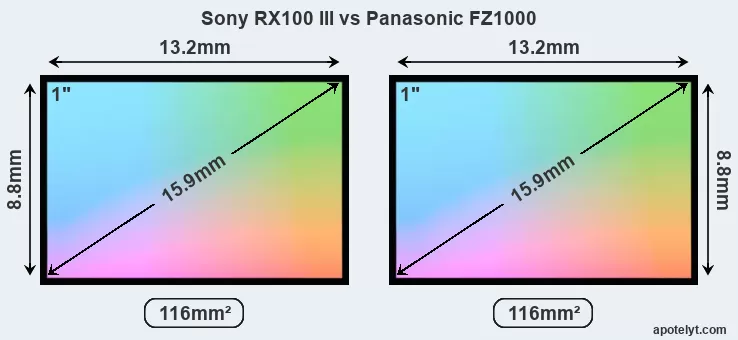
The two cameras under review do not only share the same sensor size, but also offer an identical resolution of 20 megapixels. This similarity in sensor specs implies that both the RX100 III and the FZ1000 have the same pixel density, as well as the same pixel size. Moreover, the two cameras were released in close succession, so that their sensors are from the same technological generation.
The Sony Cyber-shot DSC-RX100 III has a native sensitivity range from ISO 100 to ISO 12800, which can be extended to ISO 80-25600. The corresponding ISO settings for the Panasonic Lumix DMC-FZ1000 are ISO 125 to ISO 12800, with the possibility to increase the ISO range to 80-25600.
In terms of underlying technology, the RX100 III is build around a BSI-CMOS sensor, while the FZ1000 uses a CMOS imager. Both cameras use a Bayer filter for capturing RGB colors on a square grid of photosensors. This arrangement is found in most digital cameras.
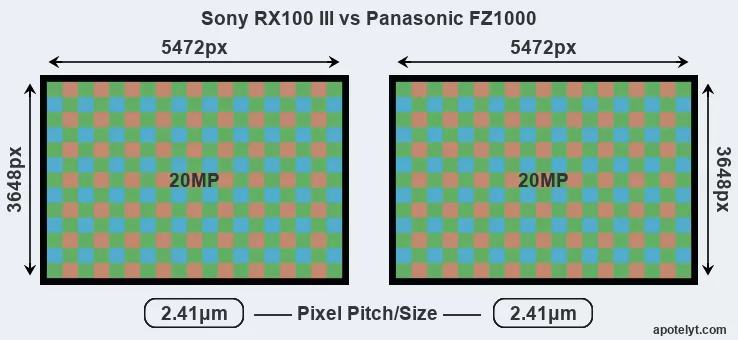
Consistent information on actual sensor performance is available from DXO Mark for many cameras. This service assesses and scores the color depth ("DXO Portrait"), dynamic range ("DXO Landscape"), and low-light sensitivity ("DXO Sports") of camera sensors, and also publishes an overall camera score. The Overall DXO ratings for the two cameras under consideration are close, suggesting that they provide similar imaging performance. The table below summarizes the physical sensor characteristics and sensor quality findings and compares them across a set of similar cameras.

| Camera Model |
Sensor Class |
Resolution (MP) |
Horiz. Pixels |
Vert. Pixels |
Video Format |
DXO Portrait |
DXO Landscape |
DXO Sports |
DXO Overall |
||
|---|---|---|---|---|---|---|---|---|---|---|---|
| 1. | Sony RX100 III | 1-inch | 20.0 | 5472 | 3648 | 1080/60p | 22.4 | 12.3 | 495 | 67 | |
| 2. | Panasonic FZ1000 | 1-inch | 20.0 | 5472 | 3648 | 4K/30p | 22.1 | 11.7 | 517 | 64 | |
| 3. | Canon G3 X | 1-inch | 20.0 | 5472 | 3648 | 1080/60p | 21.4 | 12.3 | 521 | 63 | |
| 4. | Canon G5 X | 1-inch | 20.0 | 5472 | 3648 | 1080/60p | 21.4 | 12.3 | 471 | 62 | |
| 5. | Canon G7 X | 1-inch | 20.0 | 5472 | 3648 | 1080/60p | 23.0 | 12.7 | 556 | 71 | |
| 6. | Sony RX100 | 1-inch | 20.0 | 5472 | 3648 | 1080/60p | 22.6 | 12.4 | 390 | 66 | |
| 7. | Sony RX100 II | 1-inch | 20.0 | 5472 | 3648 | 1080/60p | 22.5 | 12.4 | 483 | 67 | |
| 8. | Sony RX100 IV | 1-inch | 20.0 | 5472 | 3648 | 4K/30p | 22.8 | 12.6 | 591 | 70 | |
| 9. | Sony RX100 V | 1-inch | 20.0 | 5472 | 3648 | 4K/30p | 22.8 | 12.4 | 586 | 70 | |
| 10. | Sony RX100 VII | 1-inch | 20.0 | 5472 | 3648 | 4K/30p | 21.8 | 12.4 | 418 | 63 | |
| 11. | Sony ZV-1 | 1-inch | 20.0 | 5472 | 3648 | 4K/30p | 22.2 | 12.6 | 669 | 66 | |
| 12. | Sony ZV-1 II | 1-inch | 20.0 | 5472 | 3648 | 4K/30p | 22.3 | 12.9 | 965 | 67 | |
| Note: DXO values in italics represent estimates based on sensor size and age. | |||||||||||
Many modern cameras are not only capable of taking still images, but can also record movies. The two cameras under consideration both have sensors whose read-out speed is fast enough to capture moving pictures, but the FZ1000 provides a better video resolution than the RX100 III. It can shoot movie footage at 4K/30p, while the Sony is limited to 1080/60p.
Feature comparison
Apart from body and sensor, cameras can and do differ across a variety of features. The two cameras under review are similar with respect to both having an electronic viewfinder. However, the one in the FZ1000 offers a substantially higher resolution than the one in the RX100 III (2359k vs 1440k dots). The table below summarizes some of the other core capabilities of the Sony RX100 III and Panasonic FZ1000 in connection with corresponding information for a sample of similar cameras.

| Camera Model |
Viewfinder (Type or 000 dots) |
Control Panel (yes/no) |
LCD Specifications (inch/000 dots) |
LCD Attach- ment |
Touch Screen (yes/no) |
Max Shutter Speed * |
Max Shutter Flaps * |
Built-in Flash (yes/no) |
Built-in Image Stab |
||
|---|---|---|---|---|---|---|---|---|---|---|---|
| 1. | Sony RX100 III | 1440 | n | 3.0 / 1229 | tilting | n | 1/2000s | 10.0/s | Y | Y | |
| 2. | Panasonic FZ1000 | 2359 | n | 3.0 / 921 | swivel | n | 1/4000s | 12.0/s | Y | Y | |
| 3. | Canon G3 X | optional | n | 3.2 / 1620 | tilting | Y | 1/2000s | 5.9/s | Y | Y | |
| 4. | Canon G5 X | 2360 | n | 3.0 / 1040 | swivel | Y | 1/2000s | 5.9/s | Y | Y | |
| 5. | Canon G7 X | none | n | 3.0 / 1040 | tilting | Y | 1/2000s | 6.5/s | Y | Y | |
| 6. | Sony RX100 | none | n | 3.0 / 1229 | fixed | n | 1/2000s | 10.0/s | Y | Y | |
| 7. | Sony RX100 II | optional | n | 3.0 / 1229 | tilting | n | 1/2000s | 10.0/s | Y | Y | |
| 8. | Sony RX100 IV | 2359 | n | 3.0 / 1228 | tilting | n | 1/2000s | 16.0/s | Y | Y | |
| 9. | Sony RX100 V | 2359 | n | 3.0 / 1229 | tilting | n | 1/2000s | 24.0/s | Y | Y | |
| 10. | Sony RX100 VII | 2359 | n | 3.0 / 921 | tilting | Y | 1/2000s | 90.0/s | Y | Y | |
| 11. | Sony ZV-1 | none | n | 3.0 / 922 | swivel | Y | 1/2000s | 24.0/s | n | n | |
| 12. | Sony ZV-1 II | none | n | 3.0 / 922 | swivel | Y | 1/2000s | 24.0/s | n | n | |
| Note: *) Information refers to the mechanical shutter, unless the camera only has an electronic one. | |||||||||||
The reported shutter speed information refers to the use of the mechanical shutter. Yet, some cameras only have an electronic shutter, while others have an electronic shutter in addition to a mechanical one. In fact, the FZ1000 is one of those camera that have an additional electronic shutter, which makes completely silent shooting possible. However, this mode is less suitable for photographing moving objects (risk of rolling shutter) or shooting under artificial light sources (risk of flickering).
The Panasonic FZ1000 has an intervalometer built-in. This enables the photographer to capture time lapse sequences, such as flower blooming, a sunset or moon rise, without purchasing an external camera trigger and related software.
Both the RX100 III and the FZ1000 have zoom lenses built in. The RX100 III has a 24-70mm f/1.8-2.8 optic and the FZ1000 offers a 25-400mm f/2.8-4.0 (focal lengths in full frame equivalent terms). Hence, the Sony provides a wider angle of view at the short end than the Panasonic, but less tele-photo reach at the long end. The RX100 III offers the faster maximum aperture.
The RX100 III writes its imaging data to SDXC or Memory Stick PRO Duo cards, while the FZ1000 uses SDXC cards. Both cameras can use UHS-I cards, which provide for Ultra High Speed data transfer of up to 104 MB/s.
Connectivity comparison
For some imaging applications, the extent to which a camera can communicate with its environment can be an important aspect in the camera decision process. The table below provides an overview of the connectivity of the Sony Cyber-shot DSC-RX100 III and Panasonic Lumix DMC-FZ1000 and, in particular, the interfaces the cameras (and selected comparators) provide for accessory control and data transfer.

| Camera Model |
Hotshoe Port |
Internal Mic / Speaker |
Microphone Port |
Headphone Port |
HDMI Port |
USB Port |
WiFi Support |
NFC Support |
Bluetooth Support |
||
|---|---|---|---|---|---|---|---|---|---|---|---|
| 1. | Sony RX100 III | - | stereo / mono | - | - | micro | 2.0 | Y | Y | - | |
| 2. | Panasonic FZ1000 | Y | stereo / mono | Y | - | micro | 2.0 | Y | Y | - | |
| 3. | Canon G3 X | Y | stereo / mono | Y | Y | mini | 2.0 | Y | Y | - | |
| 4. | Canon G5 X | Y | stereo / mono | - | - | mini | 2.0 | Y | Y | - | |
| 5. | Canon G7 X | - | stereo / mono | - | - | micro | 2.0 | Y | Y | - | |
| 6. | Sony RX100 | - | stereo / mono | - | - | micro | 2.0 | - | - | - | |
| 7. | Sony RX100 II | Y | stereo / mono | - | - | micro | 2.0 | Y | Y | - | |
| 8. | Sony RX100 IV | - | stereo / mono | - | - | micro | 2.0 | Y | Y | - | |
| 9. | Sony RX100 V | - | stereo / mono | - | - | micro | 2.0 | Y | Y | - | |
| 10. | Sony RX100 VII | - | stereo / mono | Y | - | micro | 2.0 | Y | Y | Y | |
| 11. | Sony ZV-1 | Y | stereo / mono | Y | - | micro | 2.0 | Y | - | Y | |
| 12. | Sony ZV-1 II | Y | stereo / mono | Y | - | micro | 2.0 | Y | - | Y |
It is notable that the FZ1000 has a microphone port, which can help to improve the quality of audio recordings by attaching an external microphone. The RX100 III does not feature such a mic input.
Both the RX100 III and the FZ1000 have been discontinued, but can regularly be found used on ebay. The RX100 III was replaced by the Sony RX100 IV, while the FZ1000 was followed by the Panasonic FZ2500. Further information on the features and operation of the RX100 III and FZ1000 can be found, respectively, in the Sony RX100 III Manual (free pdf) or the online Panasonic FZ1000 Manual.
Review summary
So how do things add up? Is there a clear favorite between the Sony RX100 III and the Panasonic FZ1000? Which camera is better? The listing below highlights the relative strengths of the two models.

Reasons to prefer the Sony Cyber-shot DSC-RX100 III:
- More dynamic range: Captures a larger spectrum of light and dark details (0.6 EV of extra DR).
- More detailed LCD: Has a higher resolution rear screen (1229k vs 921k dots).
- Better light gathering: Has a lens with a wider maximum aperture (f/1.8 vs f/2.8).
- Wider view: Has a wider-angle lens that facilitates landscape or interior shots.
- More compact: Is smaller (102x58mm vs 137x99mm) and thus needs less room in the bag.
- Less heavy: Is lighter (by 541g or 65 percent) and hence easier to carry around.
- Easier travel charging: Can be conveniently charged via its USB port.
- More affordable: Was introduced into a lower priced segment (11 percent cheaper at launch).

Advantages of the Panasonic Lumix DMC-FZ1000:
- Better video: Provides higher definition movie capture (4K/30p vs 1080/60p).
- Better sound: Can connect to an external microphone for higher quality sound recording.
- More detailed viewfinder: Has higher resolution electronic viewfinder (2359k vs 1440k dots).
- Larger viewfinder image: Features a viewfinder with a higher magnification (0.70x vs 0.59x).
- More flexible LCD: Has a swivel screen for odd-angle shots in portrait or landscape orientation.
- Faster shutter: Has higher mechanical shutter speed (1/4000s vs 1/2000s) to freeze action.
- Faster burst: Shoots at higher frequency (12 vs 10 flaps/sec) to capture the decisive moment.
- Less disturbing: Has an electronic shutter option for completely silent shooting.
- Easier time-lapse photography: Has an intervalometer built-in for low frequency shooting.
- More tele-reach: Has a longer tele-lens for perspective compression and subject magnification.
- Longer lasting: Gets more shots (360 versus 320) out of a single battery charge.
- Better lighting: Features a hotshoe and can thus hold and trigger an external flash gun.
If the number of relative strengths (bullet points above) is taken as a guide, the FZ1000 is the clear winner of the contest (12 : 8 points). However, the relevance of individual strengths will vary across photographers, so that you might want to apply your own weighing scheme to the summary points when reflecting and deciding on a new camera. A professional wedding photographer will view the differences between cameras in a way that diverges from the perspective of a travel photog, and a person interested in cityscapes has distinct needs from a macro shooter. Hence, the decision which camera is best and worth buying is often a very personal one.
How about other alternatives? Do the specifications of the Sony RX100 III and the Panasonic FZ1000 place the cameras among the top in their class? Find out in the latest Best Travel-Zoom Camera and Best Superzoom Camera listings whether the two cameras rank among the cream of the crop.
In any case, while the comparison of the spec-sheets of cameras can offer a general idea of their imaging potential, it remains incomplete and does no justice, for example, to the way the RX100 III or the FZ1000 perform in practice. At times, user reviews, such as those published at amazon, address these issues in a useful manner, but such feedback is on many occasions incomplete, inconsistent, and unreliable.
Expert reviews
This is where reviews by experts come in. The table below provides a synthesis of the camera assessments of some of the best known photo-gear review sites (amateurphotographer [AP], cameralabs [CL], digitalcameraworld [DCW], dpreview [DPR], ephotozine [EPZ], photographyblog [PB]). As can be seen, the professional reviewers agree in many cases on the quality of different cameras, but sometimes their assessments diverge, reinforcing the earlier point that a camera decision is often a very personal choice.

| Camera Model |
AP score |
CL score |
DCW score |
DPR score |
EPZ score |
PB score |
Camera Launch |
Launch Price (USD) |
Street Price |
||
|---|---|---|---|---|---|---|---|---|---|---|---|
| 1. | Sony RX100 III | 5/5 | + + | .. | 82/100 | 4.5/5 | 5/5 | May 2014 | 799 | ebay.com | |
| 2. | Panasonic FZ1000 | 4/5 | + + | .. | 82/100 | 4.5/5 | 4.5/5 | Jun 2014 | 899 | ebay.com | |
| 3. | Canon G3 X | 3.5/5 | + | .. | .. | 4.5/5 | 4/5 | Jun 2015 | 999 | ebay.com | |
| 4. | Canon G5 X | 5/5 | + + | .. | 78/100 | 4.5/5 | 4.5/5 | Oct 2015 | 799 | ebay.com | |
| 5. | Canon G7 X | 4/5 | + + | .. | 77/100 | 4.5/5 | 4.5/5 | Sep 2014 | 699 | ebay.com | |
| 6. | Sony RX100 | 5/5 | + + | .. | 78/100 | 4/5 | 5/5 | Jun 2012 | 649 | ebay.com | |
| 7. | Sony RX100 II | 5/5 | + + | .. | 79/100 | 4.5/5 | 4.5/5 | Jun 2013 | 749 | ebay.com | |
| 8. | Sony RX100 IV | 4.5/5 | + + | .. | 85/100 | 4/5 | 4.5/5 | Jun 2015 | 999 | ebay.com | |
| 9. | Sony RX100 V | 4.5/5 | + + | .. | 83/100 | 4/5 | 4.5/5 | Oct 2016 | 999 | ebay.com | |
| 10. | Sony RX100 VII | 4.5/5 | .. | 4/5 | .. | 4/5 | 5/5 | Jul 2019 | 1,199 | amazon.com | |
| 11. | Sony ZV-1 | 4/5 | + | 4/5 | 85/100 | 4/5 | 4.5/5 | May 2020 | 799 | ebay.com | |
| 12. | Sony ZV-1 II | 4.5/5 | .. | 3.5/5 | 83/100 | 3.5/5 | 4.5/5 | May 2023 | 899 | amazon.com | |
| Note: (+ +) highly recommended; (+) recommended; (o) reviewed; (..) not available. | |||||||||||
The above review scores should be interpreted with care, though. The assessments were made in relation to similar cameras of the same technological generation. A score, therefore, has to be seen in close connection to the price and market introduction time of the camera, and rating-comparisons among cameras that span long time periods or concern very differently equipped models make little sense. Also, kindly note that some of the listed sites have over time developped their review approaches and their reporting style.

Check RX100 III offers at
ebay.com

Check FZ1000 offers at
ebay.com
Other camera comparisons
Did this review help to inform your camera decision process? In case you would like to check on the differences and similarities of other camera models, just use the search menu below. As an alternative, you can also directly jump to any one of the listed comparisons that were previously generated by the CAM-parator tool.
- Canon 1Ds vs Sony RX100 III
- Canon 750D vs Sony RX100 III
- Canon SX10 vs Panasonic FZ1000
- Canon SX510 vs Panasonic FZ1000
- Canon XTi vs Panasonic FZ1000
- Fujifilm GFX 50R vs Sony RX100 III
- Fujifilm X70 vs Sony RX100 III
- Leica X1 vs Sony RX100 III
- Olympus E-PM2 vs Panasonic FZ1000
- Panasonic FZ1000 vs Sony A7R II
- Panasonic FZ1000 vs Sony A9 III
- Panasonic G95 vs Sony RX100 III
Specifications: Sony RX100 III vs Panasonic FZ1000
Below is a side-by-side comparison of the specs of the two cameras to facilitate a quick review of their differences and common features.
| Camera Model | Sony RX100 III | Panasonic FZ1000 |
|---|---|---|
| Camera Type | Fixed lens compact camera | Fixed lens compact camera |
| Camera Lens | 24-70mm f/1.8-2.8 | 25-400mm f/2.8-4.0 |
| Launch Date | May 2014 | June 2014 |
| Launch Price | USD 799 | USD 899 |
| Sensor Specs | Sony RX100 III | Panasonic FZ1000 |
| Sensor Technology | BSI-CMOS | CMOS |
| Sensor Format | 1" Sensor | 1" Sensor |
| Sensor Size | 13.2 x 8.8 mm | 13.2 x 8.8 mm |
| Sensor Area | 116.16 mm2 | 116.16 mm2 |
| Sensor Diagonal | 15.9 mm | 15.9 mm |
| Crop Factor | 2.7x | 2.7x |
| Sensor Resolution | 20 Megapixels | 20 Megapixels |
| Image Resolution | 5472 x 3648 pixels | 5472 x 3648 pixels |
| Pixel Pitch | 2.41 μm | 2.41 μm |
| Pixel Density | 17.18 MP/cm2 | 17.18 MP/cm2 |
| Moiré control | Anti-Alias filter | Anti-Alias filter |
| Movie Capability | 1080/60p Video | 4K/30p Video |
| ISO Setting | 100 - 12,800 ISO | 125 - 12,800 ISO |
| ISO Boost | 80 - 25,600 ISO | 80 - 25,600 ISO |
| Image Processor | BIONZ X | Venus |
| DXO Sensor Quality (score) | 67 | 64 |
| DXO Color Depth (bits) | 22.4 | 22.1 |
| DXO Dynamic Range (EV) | 12.3 | 11.7 |
| DXO Low Light (ISO) | 495 | 517 |
| Screen Specs | Sony RX100 III | Panasonic FZ1000 |
| Viewfinder Type | Electronic viewfinder | Electronic viewfinder |
| Viewfinder Field of View | 100% | 100% |
| Viewfinder Magnification | 0.59x | 0.70x |
| Viewfinder Resolution | 1440k dots | 2359k dots |
| LCD Framing | Live View | Live View |
| Rear LCD Size | 3.0inch | 3.0inch |
| LCD Resolution | 1229k dots | 921k dots |
| LCD Attachment | Tilting screen | Swivel screen |
| Shooting Specs | Sony RX100 III | Panasonic FZ1000 |
| Focus System | Contrast-detect AF | Contrast-detect AF |
| Manual Focusing Aid | Focus Peaking | Focus Peaking |
| Max Shutter Speed (mechanical) | 1/2000s | 1/4000s |
| Continuous Shooting | 10 shutter flaps/s | 12 shutter flaps/s |
| Electronic Shutter | no E-Shutter | up to 1/16000s |
| Time-Lapse Photography | no Intervalometer | Intervalometer built-in |
| Fill Flash | Built-in Flash | Built-in Flash |
| Storage Medium | MS or SDXC cards | SDXC cards |
| Single or Dual Card Slots | Single card slot | Single card slot |
| UHS card support | UHS-I | UHS-I |
| Connectivity Specs | Sony RX100 III | Panasonic FZ1000 |
| External Flash | no Hotshoe | Hotshoe |
| USB Connector | USB 2.0 | USB 2.0 |
| HDMI Port | micro HDMI | micro HDMI |
| Microphone Port | no MIC socket | External MIC port |
| Wifi Support | Wifi built-in | Wifi built-in |
| Near-Field Communication | NFC built-in | NFC built-in |
| Body Specs | Sony RX100 III | Panasonic FZ1000 |
| Battery Type | Sony NP-BX1 | Panasonic DMW-BLC12 |
| Battery Life (CIPA) | 320 shots per charge | 360 shots per charge |
| In-Camera Charging | USB charging | no USB charging |
| Body Dimensions |
102 x 58 x 41 mm (4.0 x 2.3 x 1.6 in) |
137 x 99 x 131 mm (5.4 x 3.9 x 5.2 in) |
| Camera Weight | 290 g (10.2 oz) | 831 g (29.3 oz) |

Check RX100 III offers at
ebay.com

Check FZ1000 offers at
ebay.com
Did you notice an error on this page? If so, please get in touch, so that we can correct the information.

